Workday Training in New York City, New York, USA
Workday BIRT Tutorial
Optimising Data Binding and Reporting in Workday BIRT
A key aspect of using Workday BIRT is understanding how the different layers interact. We can easily link secondary business subjects with primary business subjects seamlessly through its intuitive user interface – for instance, using row numbers as connectors between objects to ensure smooth data integration.
Workday BIRT makes retrieving monthly payment currency information effortless; by simply browsing within tables, we can access various financial details directly.
Formatting data within Workday BIRT plays a crucial role in presenting its information in an intuitive visual format.
From HTML formatting to table organisation, Workday BIRT’s formatting features provide flexibility for dynamically displaying information dynamically.
Deploying Workday BIRT reports introduces an additional level of complexity. To ensure proper output from our generated reports, the layout must align with report design specifications.
Large data sets consisting of thousands of records can require optimisation for an effortless execution experience.
Workday BIRT facilitates the efficient management of large datasets. Understanding multi-instance fields is crucial, as every Workday BIRT field must align to support structured report development.
For example, when creating compensation statements, this means that all relevant information appears on a dedicated page per employee.
These concepts and best practices are commonly covered in a Workday BIRT tutorial in New York, making it a valuable learning opportunity for professionals.
Workday BIRT stands out with its ability to organise records based on individual requirements.
From financial transactions and employee records to inventory tracking or building analytics reports, Workday BIRT adapts perfectly.
It allows us to gain meaningful insights through data visualisation. Inserting tables and structuring content systematically ensures an impactful representation.
Through various configuration options, we can explore Workday BIRT’s capabilities while tailoring solutions specifically to individual business requirements.
Workday BIRT gives professionals working with structured data a set of tools for quickly creating reports to meet operational demands, regardless of complexity. Thanks to its adaptability, Workday BIRT remains an indispensable companion. Workday BIRT tutorial in New York provides an opportunity to master these skills.
Binding Secondary Data Sets in Workday BIRT: Let’s discuss Workday BIRT and the significance of binding secondary data sets.
Often, when creating reports, we overlook an essential step — binding secondary data sets — that could prevent our reports from functioning correctly and miss out on valuable insights that would otherwise become apparent.
Workday BIRT makes adding business objects a game changer; we can introduce additional data elements that further strengthen reports while simultaneously covering more ground.
It provides us with the flexibility to incorporate multiple objects, making data analysis dynamic and comprehensive.
It enables us to refine our approach, creating reports with all the necessary details for in-depth analysis.
By carefully managing secondary data sets, we can produce accurate representations of the information required for informed decisions.
Workday BIRT makes binding secondary data sets not just a technical step but rather an integral component of producing quality reports.
When we apply this tool effectively, Workday BIRT transforms how we handle information while streamlining reporting with precision and efficiency.
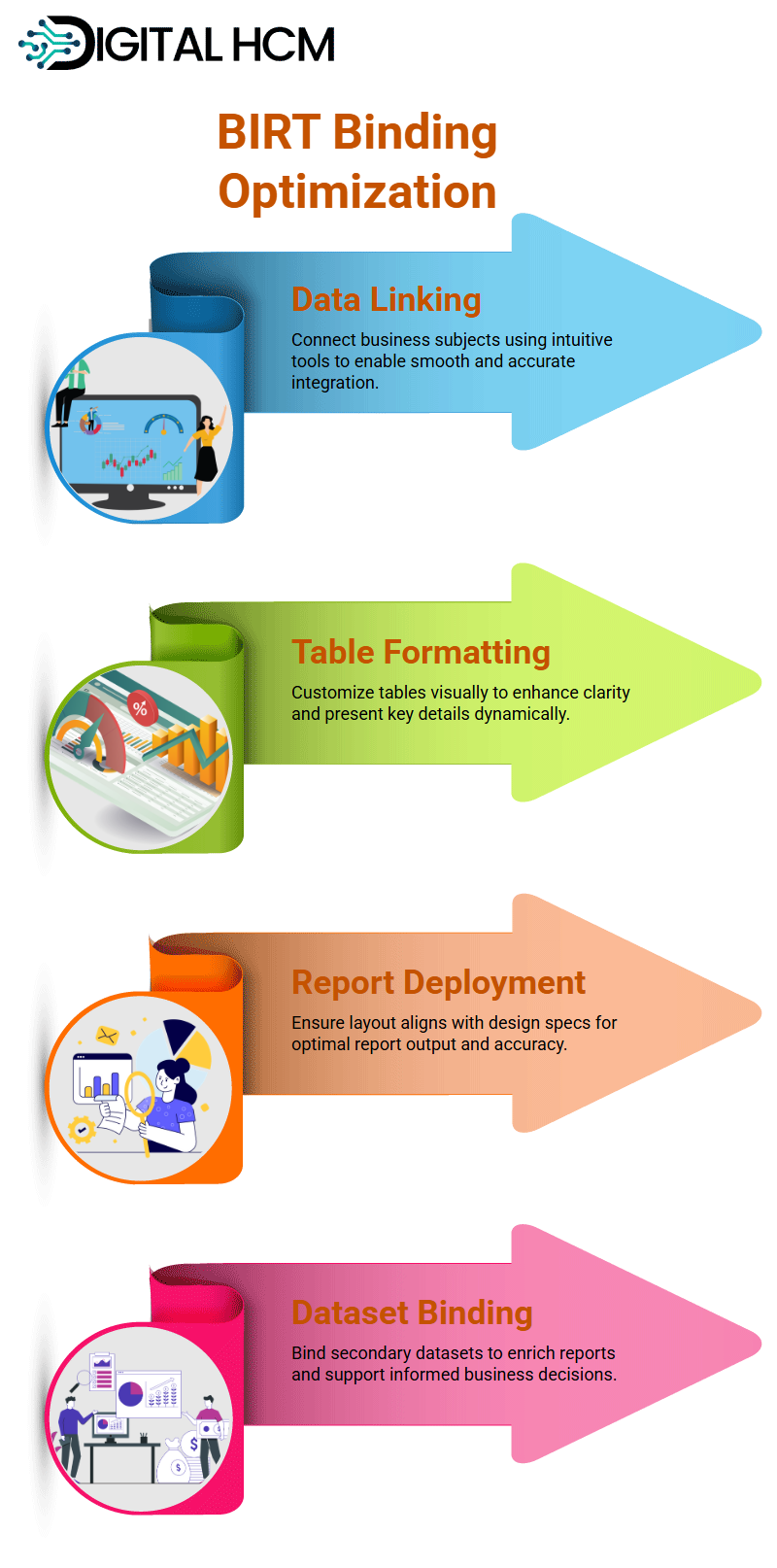
Enhancing Workday BIRT Report Accuracy
An often-overlooked aspect of Workday BIRT is properly integrating secondary data. While we might assume it will come together automatically, without proper binding, your reports won’t reflect all available information.
Workday BIRT enables users to quickly add and manage multiple business objects in reports, making reports more insightful and aligned with real business needs.
The Workday BIRT tutorial in New York helps users effectively grasp these capabilities. Workday BIRT enables us to customise our reporting structure, ensuring that every piece of data is accurately counted and linked to secondary datasets, providing us with reliable reports that support informed business decisions.
Once adjustments were made, the reports became much more informative, providing clear and actionable insights.
It goes beyond simply producing reports—it also refines them, ensuring that data is presented meaningfully and in a structured format.
Mastering Workday BIRT’s secondary data binding process elevates reporting quality for more impactful reports.
Workday BIRT for Accurate and Efficient Reporting
Workday BIRT is an indispensable tool for customising business reports within Workday, from financial statements to transaction logs or audit trails – Workday BIRT makes the data structure clear.
It requires multiple business objects to work seamlessly together for optimal report layout and presentation.
Each grid should align with specific data points for detailed examination and analysis. Workday BIRT tutorial in NY covers these advanced structuring techniques.
At our session, we explored various possibilities for using Workday BIRT with financial data. From bank statement lines and currency details to optimising reporting structures, Workday BIRT provided an efficient means of refining reporting structures.
Reports can also help us track changes to transactions. With audit trails enabled on Workday BIRT reports, tracking modifications at the field level provides us with a more precise picture of financial activities.
Workday BIRT simplifies the identification of relevant business objects. By selecting relevant data fields, such as account details and statement values, we enhance report quality while ensuring accurate financial assessments.
One key takeaway from our discussion was Workday BIRT’s versatility in handling different reporting parameters efficiently and creating comprehensive reports tailored to business requirements.
This feature enables efficient data management while meeting reporting needs in alignment with business goals.
Workday BIRT tutorial in NY explores these techniques in depth. Workday BIRT reports are revolutionary because of their dynamic financial elements’ capability, whether that means currency values or bank account details, providing accurate reporting without complications or delays.
As we advance, effectively using Workday BIRT requires selecting appropriate business objects and ensuring data integration is conducted smoothly.
Thanks to its structured nature, Workday BIRT remains a reliable and efficient reporting solution for businesses of all kinds.
Workday BIRT plays an essential role in financial reporting, so today we explore its core elements that make it such an efficient solution.
From statement layout management to configuring data visibility settings, Workday BIRT streamlines these processes seamlessly for maximum productivity.
As part of your setup process, we begin by structuring a grid. Adding columns at various levels ensures every data point is displayed appropriately in the Workday BIRT system.
Our focus should always be on clarity by including only relevant information in reports – no unnecessary blanks!
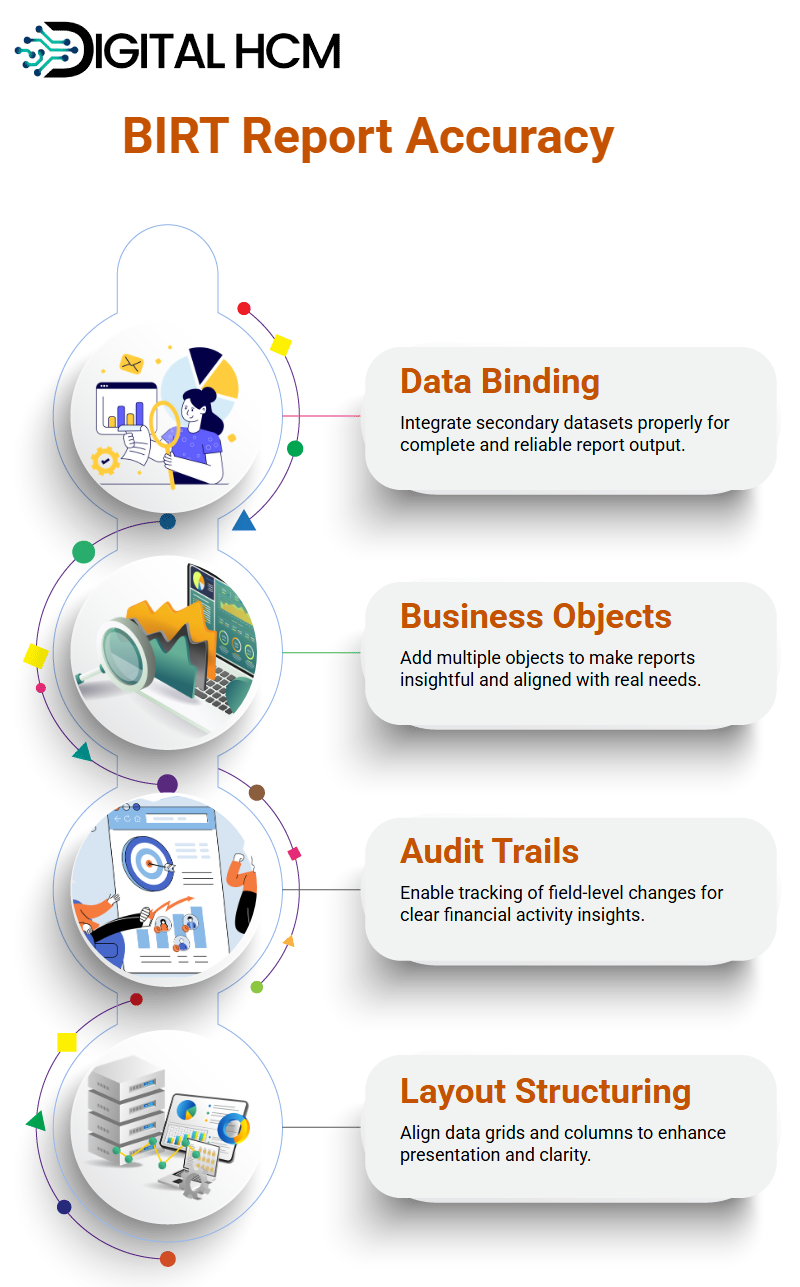
Workday BIRT Column Management
Now let’s focus on managing data columns effectively: we are using five columns in Workday BIRT to organise financial transactions efficiently by distinguishing debit from credit entries for easier management, thus eliminating confusion among employees and consumers alike.
Workday BIRT tutorial in NY offers practical guidance on structuring such reports. Situations may arise where the type determines which values to record in which columns.
The Workday BIRT system must utilise its capabilities to effectively suppress blank fields while accurately representing available transactions to enhance report readability.
Handling Statement Transactions in Workday BIRT
Statement transactions require a strategic and structured approach in Workday BIRT to ensure accuracy and avoid outdated information skewing the analysis process.
When updated data appears in reports, refreshing its source should occur as needed to maintain accurate analysis results.
Workday BIRT tutorial in NY covers techniques like these to ensure reporting accuracy. Workday BIRT ensures that any new data fields or removals are accurately reflected when introduced or subtracted from an account, while validation rules ensure precision with financial entries.
Effective Workday BIRT Layout Design
Wagering Changes on Report Generation in WFBIRT: Any modifications made within WFBIRT can have direct ramifications on report production.
When statement records contain many entries, optimising their format reduces redundancies while speeding up processing.
Workday BIRT helps streamline reports by consolidating multiple line items onto fewer pages, providing efficient representation and increasing clarity while conserving resources.
Enhance Workday BIRT through Report Accuracy
One of Workday BIRT’s key strengths lies in its ability to interpret XML reports accurately.
Each financial statement conforms to predefined configurations, creating consistent data output.
Reports undergo multiple validation steps to ensure their reliability, with transactions meticulously recorded to provide a comprehensive financial overview.
Workday BIRT tutorial in USA often highlights features like these to help users optimise report layouts.
This makes managing complex report layouts stress-free and straightforward. If your reports feature multiple rows, there’s now an effortless solution available: Workday BIRT can condense everything into a single column using its drag-and-drop technology.
Workday BIRT simplifies life by enabling the direct integration of multi-instance calculations. As such, reports without unnecessary row splits and single XML loads are generated easily and more efficiently by this system.
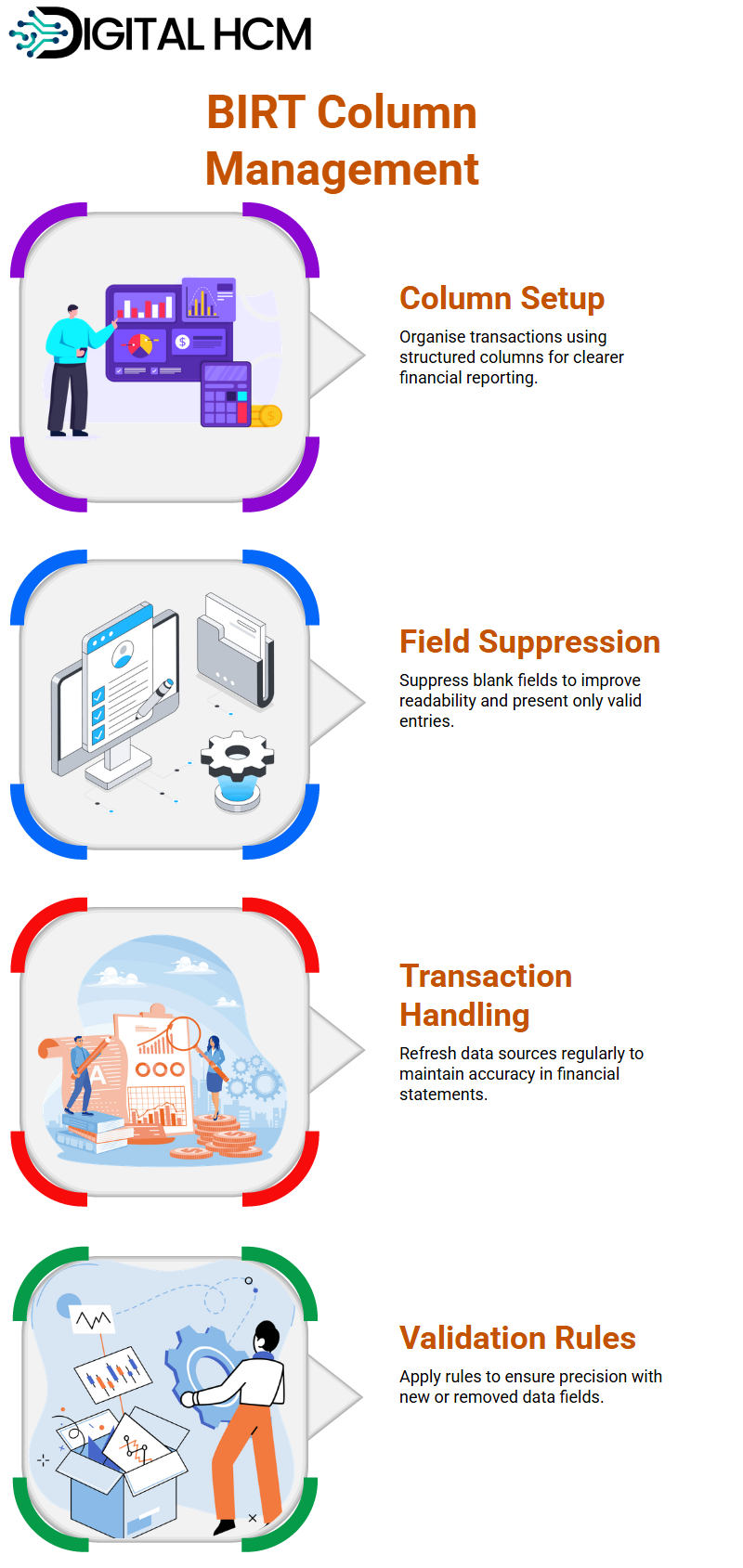
Avoid Unwanted Rows in Workday BIRT Reports
Are your PDF output reports featuring too many rows? By making adjustments to the transformation settings, Workday BIRT provides a solution with a seamless data flow into a single table.
Workday BIRT simplifies report layout customisation by offering customizable settings at the layout level, allowing you to arrange all records within a single table.
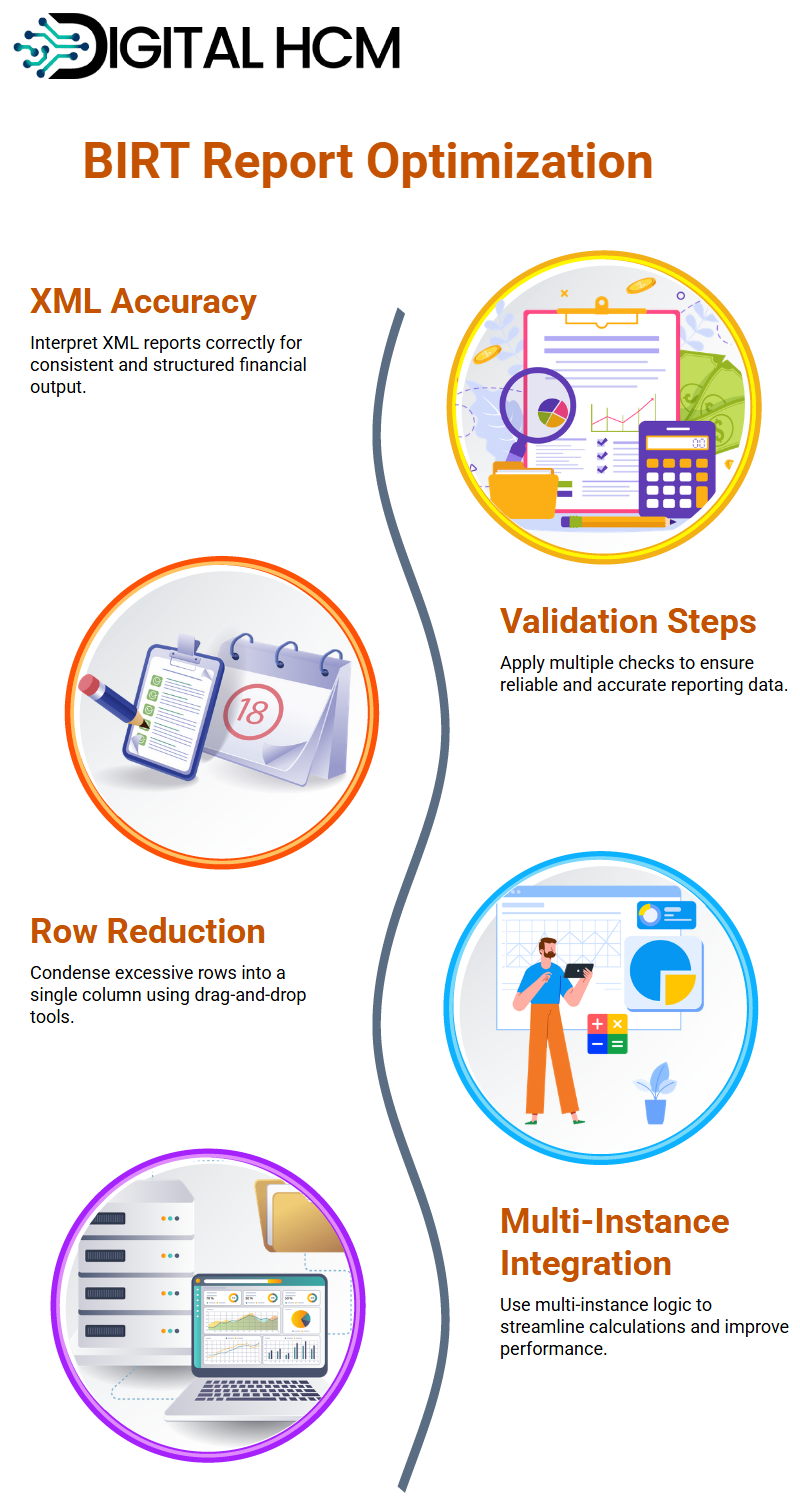
Optimising Data Formats with Workday BIRT
Workday BIRT is more than just a PDF report platform; it also allows you to transform data directly into text format without relying on integrations.
By choosing an appropriate transformation setting, text outputs with separators such as commas or pipes become possible.
Workday BIRT simplifies data transformation by automating this step, saving both time and energy that would be spent on manual tasks.
Workday BIRT Makes Transforming Reports Efficient
Transforming custom reports using Workday BIRT is easy! No complicated code is necessary: select the file extension “.txt,” adjust transformation settings accordingly, and let Workday BIRT handle everything for you!
Workday BIRT makes report customisation easy and efficient, providing data in its original format without error or waste.
Mastering Workday BIRT for Precise Data Representation
Today, we will cover an essential element of template design: Working with Workday BIRT. Anyone familiar with Workday BIRT knows just how essential formatting accuracy can be when working with templates in this format.
Workday BIRT tutorial in USA often emphasises these formatting best practices. Workday BIRT enables us to structure relevant fields, presenting data in a seamless and efficient manner.
One of the primary challenges associated with Workday BIRT output lies in aligning grid cells within tables.
If they extend beyond these borders, errors occur that interrupt output, causing disruptions within Workday BIRT’s output process.
This should always remain within their boundaries. Therefore, the grid must stay within these parameters.
Best Practices for Workday BIRT Template Validation
Validating is key when building templates using Workday BIRT, as checking that HTML structures remain intact helps prevent layout errors and ensures a smooth workflow without interruptions or disruptions to your template’s flow.
Workday BIRT also provides ways to accomplish this task. Implementing our template within Workday enables us to verify how it populates each employee’s data easily.
Adjustments made through Workday BIRT may help refine the output and ensure better alignment of our staffing practices.
Workday BIRT tutorial in USA highlights these validation techniques to help users create flawless templates.
It provides structured formatting to guarantee reliable document generation. If you’re struggling with template design, taking appropriate validation steps will help keep Workday BIRT layouts functioning efficiently and operating at full potential.
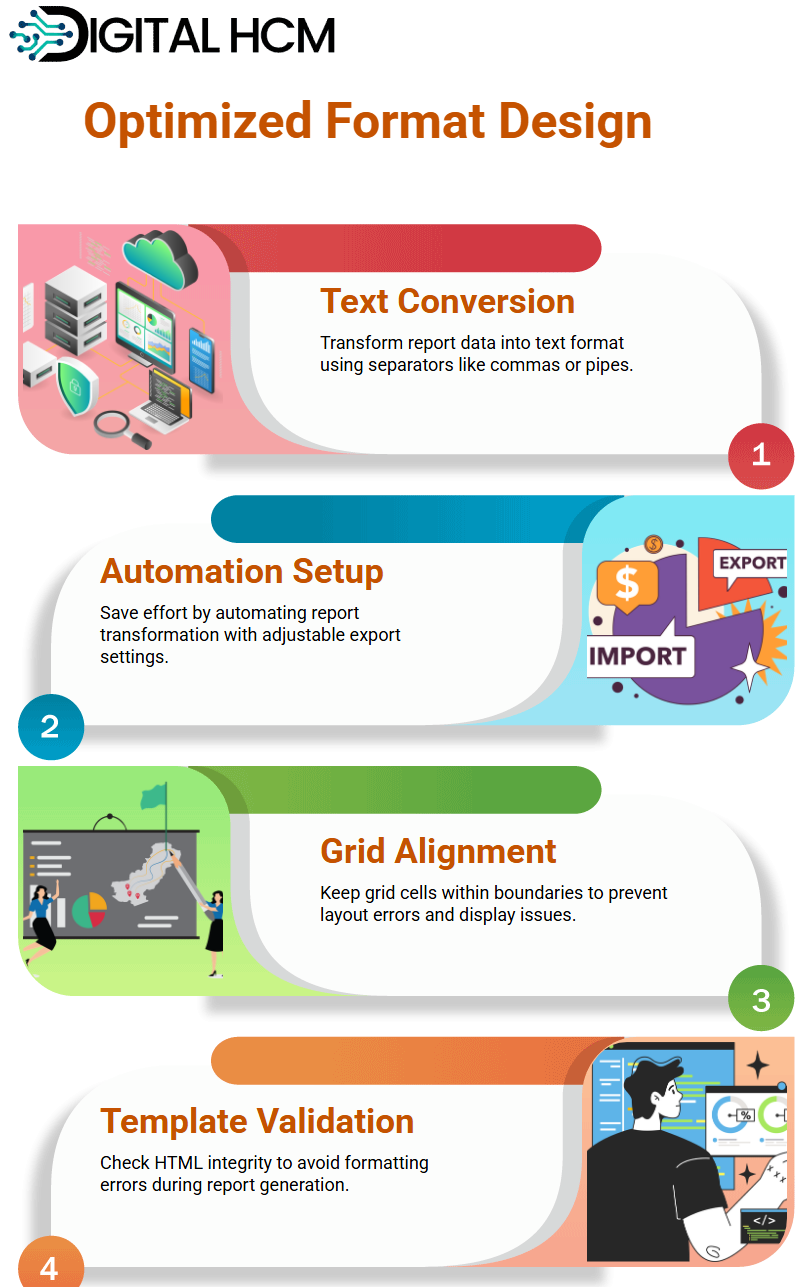
Deploying Workday BIRT Templates to Represent Data Accurately
After creating the template, the next step should be its deployment within Workday BIRT to ensure all fields have been accurately mapped and that data appears accurately as anticipated. This process ensures a successful experience.
Once deployed in Workday BIRT, running each employee layout provides insight into how its design performs in actual conditions – adjustments may need to be made for improved field placements and accuracy.
Utilising the Workday BIRT tutorial in USA effectively ensures the development of error-free templates that meet business requirements.
If you have any inquiries about Workday BIRT template deployment, don’t hesitate to ask – your call may be taken seriously and answered as quickly as possible.

James

Success in your career comes from curiosity, courage, and consistency. Stay committed, stay curious and never stop learning.
